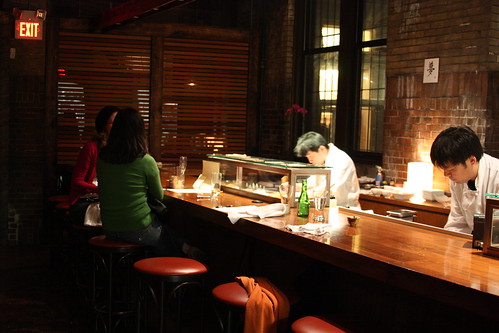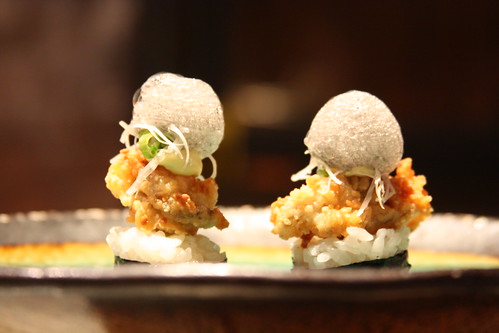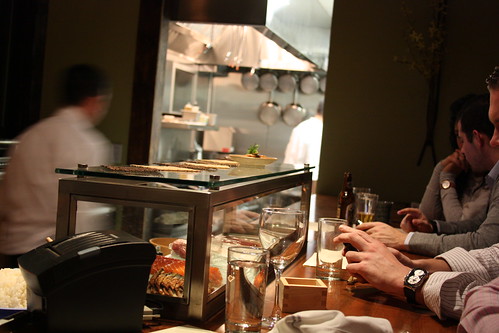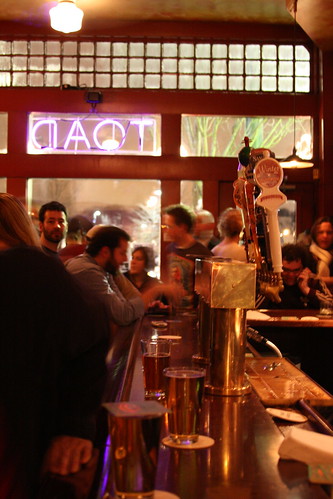
photo by nickphotos on Flickr
Working in restaurants was never meant to be a career I’d fall in love with. It was a means to cover my bills until I reached my goal of becoming a professional screenwriter. Despite my creative aspirations, however, by the spring of 1998 I was thoroughly embedded in the restaurant scene in Cambridge/Boston. I was the only female bartender—a singular position I relished—at Toad, a popular locals’ bar and music club (albeit tiny) in Porter Square, Cambridge. Four nights a week I was the person that everybody knew–the friendly bartender to regulars, tourists, Harvard academics, rocket scientists and musicians like Patty Griffin, Peter Mulvey, Ellis Paul and the band Morphine. At Toad, everybody really did know your name.
The excitement I felt working at Toad (and their sister restaurant Christopher’s), was a kind of siren song of easy money, camaraderie, casual lifestyle and untraditional hours that was so completely beguiling I felt the need to flee the Boston area—for fear I would never truly break free of the world’s best bartending job and pursue my dream of becoming a screenwriter. An acceptance letter to a prestigious film school was the solid lead I needed to empower me to leave behind the pull of Boston’s budding dining scene.
In the early 1990’s, Boston’s culinary scene saw its first spark of national attention when Boston Chef Todd English earned his James Beard award and was named best chef of the Northeast. Other hot young chefs like Chris Schlesinger (East Coast Grill), Gordon Hamersley (Hamersley’s), Lydia Shire (Biba) and Paul O’Connell (Chez Henri) gained notoriety for their innovative cooking. In a town that was once known only for its pubs, clam chowder and baked beans, these and a handful of other Boston-based chefs, busied themselves with creating New England-inspired menus and revelatory dining experiences that would soon make Boston and Cambridge a culinary destination.
Distance makes the heart grow stronger
Despite the ache to revisit the haunts of my old life, I kept my distance from Boston and Cambridge for a decade. Like a broken hearted lover might stay away from an old flame, I feared that one good visit might make me throw in the towel on my film writing career and go back to what I once had when I was in Boston.
Of course, the lure of restaurants was too strong to resist. As I continued to be disciplined about writing screenplays, my work in restaurants was something that was difficult for me to leave behind entirely. Though I continued to write screenplays, I secretly imagined myself a future restaurateur.
I read with interest the stories of great Boston restaurants emerging in my old neighborhood. Friends from back home told me of bustling breweries, high-end pizza shops and fine dining establishments replacing old pubs. Family shared culinary gossip about burrito joints and Asian restaurants sprouting up in a city where the only ethnic food to be found was Italian. In 2004, I felt the first real pang of missing the Cambridge dining scene when I saw my old friend Tony Maws on the cover of Food and Wine’s best new chef issue, for his newly opened Cambridge restaurant Craigie Street Bistro.
As the years passed, my work within restaurants morphed and altered the focus of my writing. In 2007, I embraced my shadow side and began exploring my love of food and restaurants when I began writing this food blog. Then in 2008, I read Frank Bruni’s review of the country’s best restaurants and his pick for the number one restaurant outside of New York City—a Boston-based Japanese restaurant named O-Ya. After a decade of keeping my distance, I was ready to see what had become of my beloved Boston/Cambridge dining scene. It was time to go home for dinner.
Then and Now
The plan: to see just how much the Boston/Cambridge dining scene has changed and just how much has stayed the same. My husband and I flew out of LA early in the morning and planned to land in Boston hungry and get to eating right away. We would try Boston’s most celebrated restaurant and visit my old stomping grounds. First stop: dinner at O-Ya.
Chef Tim Cushman and sommelier Nancy Cushman, are the charming husband and wife team behind this 37-seat restaurant (17 of the seats are at the Chef’s counter). The award winning restaurant is a tiny oasis of warmth in a snow draped city. The interior–a renovated firehouse–features arched-beams, warm wood and brick walls, cozy seating and cool tunes. The Cushmans and their professional staff lavish the diners with an uncommon grace and a menu dedicated to only the finest ingredients.
Since its opening in 2007, O-Ya has been called best new restaurant by numerous publications (Boston Magazine, Zagat, Robb Report, Gourmet) and Tim Cushman received a best new chef of 2008 award by Food and Wine Magazine. Cushman—a New England native—has a diverse culinary background in Japanese cuisine. He sources ingredients shipped from as far away as Japan and Santa Barbara while at the same time prizing the local Boston fishmarkets. With some 80 small plates—an exciting mix of Nigiri sushi, sashimi, udon, tempura, as well as cooked pork, chicken and wagyu beef dishes—O-Ya is an exciting restaurant for all types of palates.
My husband and I enter O-Ya a few minutes before our reservation. We are greeted by Nancy Cushman, a striking young woman with the presence of a doyenne. An immediately warm host, Nancy ushers us to our seats at the Chef’s table (the sushi bar). She welcomes us as if we were long lost friends.
We squirm in our seats like excited school children as we scan the small plates menu. With some helpful suggestions from our server, we order. As a 1920’s jazz tune plays as we study the happy faces of the diners and admire the dance of white chef coats as the sushi chef deftly craft the diverse and sometimes architectural raw fish dishes.
As we await the beginning of our meal, Nancy arrives with a ceramic dish topped with shaved ice and a selection of hand made sake cups. Our clever hosts offers us the plate and asks us to select our cup.
“Don’t worry,” she smiles. “This isn’t a
psychological test.” My husband and I smile and take our individual glasses. Nancy pours our Yuki no Bosha Junmai Ginjo sake ($38for a 300ml half bottle) and has us taste. The flavors are subtle and complex with floral clean notes. A perfect cold sake for our meal. As Nancy walks away, my husband and I can’t help but wonder aloud that maybe the glasses we pick really do say something about our personalities. Mine is wide mouthed and speckled brown like a pony. His is tall, lean and colored black as night with a blue lip. We are busy musing on the meaning of our glasses as the first dish arrives. It’s a stunner.
A tempura fried Kumamoto oyster ($14) sits atop nori-wrapped sushi rice with a yuzu kosho aioli and a perfect sphere of squid ink foam. It’s a perfect bite of soft rice, salty-sweet meat of the oyster, delightful crunch of tempura and a playful brininess from the squid ink bubbles. My husband and I lower our heads in reverence to the chef. We know we are in great hands.
It’s impossible not to appreciate the artistry of the sushi chefs. Their movements are that of an orchestra conductor; a hand rises to prolong a beautiful note of flavor, as the chef carefully adjusts the amount of chives to layer atop a dish. Watching great sushi chefs work is like watching a kind of gastronomic folk dance—the way their hands cup to form a curve of sushi rice, or their fingers fly over a piece of fish—all of these culinary gestures that have been perfected and handed down for centuries.
The diver sea scallop sashimi ($18) arrives on a long, glass dish that resembles a slab of polished ice. The sweet tender scallop is sliced thin, topped with a tempura fried sage leaf and olive oil foam. This is raw scallops at their best—their briny sweetness play against the exciting crunch of sage and intriguing texture of collapsing olive oil foam.
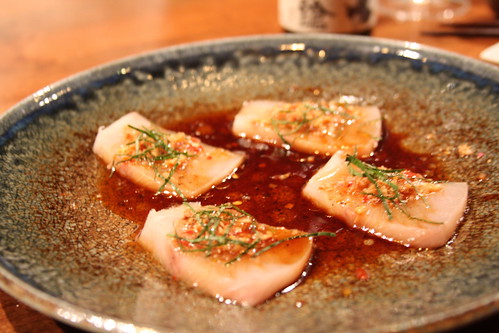
The hand cut squares of hamachi sashimi ($21) arrive swimming in a shallow bath of Vietnamese mignonette and topped with a julienne of Thai basil and chopped shallot. The sweet acidity cuts through the natural fattiness of the fish and the anise flavored Thai basil and red chili give the dish a refreshing jolt of spice.
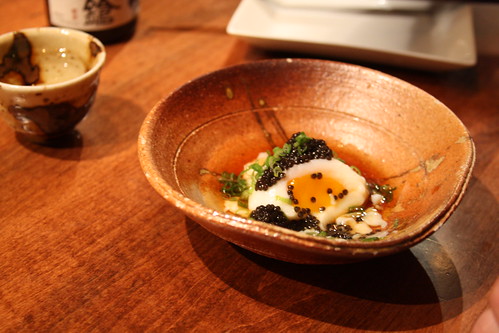
Feeling the freedom that only a few glasses of great sake can give, we order the Faberge Onsen Egg ($38)–a slow-cooked soft-poached egg (it’s cooked in a water bath of a sustained 62 degrees) that’s topped with a generous scoop of black river Ossetra caviar in a shallow puddle of sweet, thick dashi sauce and green onion. The poached egg is almost translucent—like a polished glass egg—and once broken, the egg white holds its form as the center yolk mixes with the textured dashi sauce. The salty caviar and spike of flavor from the green onion is too much for my husband and I. The sushi chef blushes as we moan in unison.
“Lots of caviar,” he nods, seemingly understanding our current state.
The sake braised shortribs ($32) arrive on a bed of dashi soy simmered potatoes. The dark, iron rich meat’s dry texture breaks apart and begs for the moisture of the veal-stock sauce beneath it. The soft textures are set off by the crispy tempura fried onions and ginger. Though flavorful, after the four star dishes I’ve tasted so far, this transitional dish into the cooked portion of the menu made me realize the Cushmans are human.

Tea brined pork ribs ($16), cooked in hot sesame oil, honey, scallions. The two rib dish reminds me of a gourmet version of teriyaki beef I used to crave as a kid. The ribs’ meat is fall-from-the-bone moist (the kind of moisture that you can only get from slow cooking) and tastes like meat candy with its lick your fingers brown scallion sesame sauce.

To finish we order the chocolate gelato with a caramel mousse. The dessert offers sweetness and a final touch of savory with its salty, dry choclate flavors and fluffy caramel sauce that’s set against a light crunch of sesame.
With the evening coming to a close, my husband and I admire the restaurant as the evening’s last diners finish their meal. As I feared I might, by the end of the meal I find myself imagining myself packing a bag, moving back home, and working as a server in the restaurant. Though my dream to write full time continues, for me, the mark of a great restaurant is one that makes me want to drop everything and work there.
Some things never change
My husband and I take the T (public train) to Porter Square Cambridge to see just how much or how little things have changed at Toad. Just as I left it, the little bar has a line out the door of twenty-something Cambridge-ites waiting to get inside the tiny club. Once inside, I realize that though the faces of the customers are unfamiliar, nothing has changed in this place.
With the exception of the state mandated smoke free environment, Toad hasn’t changed much at all. As a matter of fact, three of my co-workers from more than 12 years ago still work there several nights a week. The graffiti has been painted over and drawn over by new hands. But there’s still the same old beer stained ceiling, not-yet-discovered talent singing on the miniscule stage and customers eating hardened piles of nacho chips from metal to-go containers. Just as they had when I left ten years ago, the ceramic toads that once looked down on me as I poured beer after beer, still hold their position on upper columns of the wood bar.
As I stepped up to the bar to order a Boddington’s beer and a shot of Maker’s Mark for old time’s sake, just like the old days, there was a friendly face behind the
bar ready to give me service with smile. Some things change. Some things don’t.


